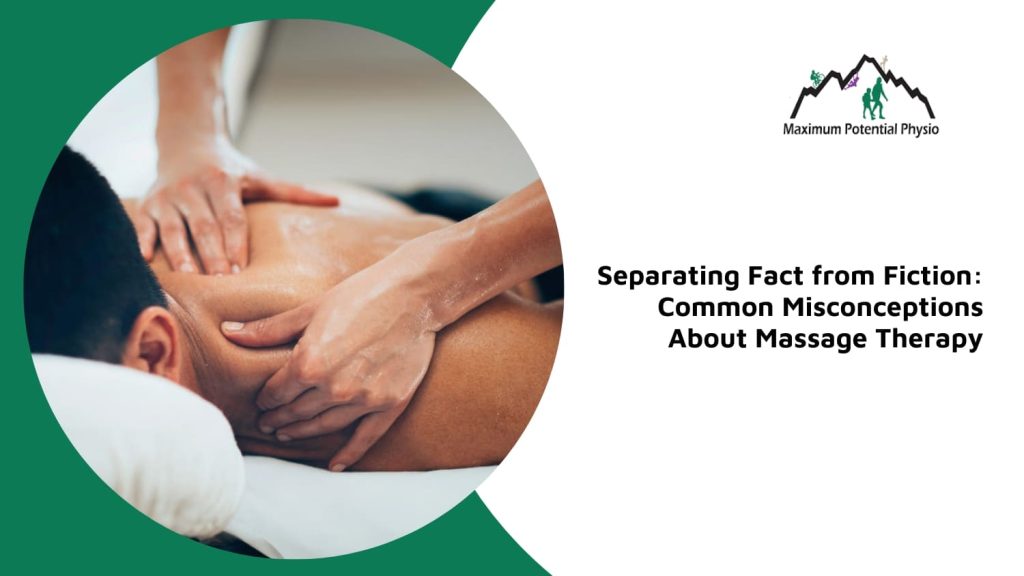Separating Fact from Fiction: Common Misconceptions About Massage Therapy

Massage therapy has long been associated with luxury and relaxation, but its therapeutic potential goes far beyond what happens at a spa. From aiding in injury recovery to managing chronic pain, massage is widely used in clinical and rehabilitative settings. Yet, despite its growing role in modern healthcare, many misconceptions persist about what massage therapy can actually do—and who it’s meant for. Is it supposed to hurt? Can it cure chronic illness? Do only athletes benefit from it? In this blog, we’ll explore and debunk some of the most common myths surrounding massage therapy.
Is Massage Therapy Only for Relaxation?
Massage therapy is often associated with spa days and stress relief, but its benefits extend far beyond relaxation. While calming the nervous system is one of its effects, massage plays a much broader role in health and well-being:
- Pain Management and Injury Recovery: Massage techniques can reduce muscle tension, promote circulation, and aid in the healing of soft tissue injuries such as strains or sprains.
- Postural Correction: Chronic postural imbalances can be improved through targeted massage work, especially in areas like the neck, shoulders, and lower back.
- Improved Circulation and Lymphatic Flow: Massage stimulates blood flow and assists with lymphatic drainage, which can reduce swelling and support immune function.
- Neuromuscular Rehabilitation: Techniques like trigger point therapy and myofascial release help reset faulty muscle patterns and relieve referred pain.
- Support for Mental Health: Massage has been shown to reduce cortisol levels and support mood regulation, making it a valuable complement to treatments for anxiety or depression.
- Enhanced Athletic Performance: Athletes use massage not just for recovery but also to improve flexibility, manage fatigue, and prevent injury.
While relaxation is a common outcome, massage therapy offers far more—serving as a therapeutic tool for various physical and psychological conditions.
Is Massage Therapy Supposed to Be Painful?
A common misconception is that massage therapy must be painful to be effective, especially when treating tight muscles or chronic tension. In reality, while some techniques like deep tissue or trigger point therapy may cause temporary discomfort, massage should never cross the threshold into sharp or unbearable pain. Communication between therapist and client is essential. Most registered massage therapists will ask for feedback throughout the session to ensure pressure is appropriate and therapeutic rather than overwhelming.
A slight soreness the day after—similar to what you might feel after a workout—is normal, but bruising or lingering pain is not a sign of success. In fact, excessive pressure can backfire by causing muscles to tense up further or inflaming the tissues being treated. Massage therapy is most beneficial when it encourages the body to relax and respond positively to manual manipulation, not when it causes distress or resistance. If you ever experience pain during a session, it’s important to speak up so adjustments can be made immediately.
Is Massage Therapy Not Safe for Older Adults?
Massage therapy is not only safe for older adults—it can be incredibly beneficial when tailored to individual needs. Myths about fragility often overshadow the advantages, but with proper assessment and adaptation, massage offers many age-specific benefits:
- Relieves Joint Stiffness and Muscle Tension: Older adults often experience tightness from arthritis or reduced mobility, which massage can help alleviate.
- Improves Circulation: Gentle massage boosts blood flow to the limbs, helping address common issues like cold hands and feet or swelling in the lower legs.
- Enhances Mobility and Balance: Targeted techniques can reduce muscular imbalances and support better posture, reducing the risk of falls.
- Eases Chronic Pain: Conditions such as osteoarthritis, sciatica, or degenerative disc disease often respond well to therapeutic massage, especially when combined with other treatments.
- Supports Emotional Wellbeing: Many seniors experience loneliness or anxiety, and therapeutic touch can provide emotional comfort and nervous system regulation.
- Gentle Techniques Available: Swedish massage and light-pressure therapies can be modified to accommodate health concerns such as osteoporosis, blood thinning medications, or sensitivity.
Massage therapy for seniors is both safe and effective when performed by trained professionals who understand age-related considerations.
Can Massage Therapy Eliminate Chronic Conditions Completely?
Massage therapy is a valuable tool for managing chronic conditions, but it should not be viewed as a cure. Conditions such as fibromyalgia, arthritis, or chronic tension headaches often have complex origins involving biomechanics, nervous system activity, and lifestyle factors. While massage can provide significant symptom relief—such as reducing pain, improving mobility, or alleviating stress—it is typically one part of a larger care plan. Regular massage may help reduce the frequency or intensity of symptoms and improve quality of life, but it does not eliminate the underlying condition. The goal is often long-term management rather than complete resolution. A collaborative approach that includes physiotherapy, exercise, medication (if needed), and massage therapy tends to offer the best outcomes.
Clients should also recognize that chronic conditions fluctuate, and what works one month might need adjusting the next. Understanding the role massage plays in a broader treatment strategy helps set realistic expectations for both short-term relief and long-term progress.
Is Massage Therapy Only for Athletes or Active People?
Another common misconception is that massage is only useful for athletes or people with physically demanding lifestyles. In reality, many individuals benefit from massage, regardless of their activity level:
- Office Workers and Sedentary Individuals: Prolonged sitting can cause postural imbalances, neck stiffness, and back pain—all of which respond well to massage therapy.
- People with Stress or Anxiety: Massage helps calm the nervous system, promoting relaxation and reducing cortisol levels.
- Individuals with Chronic Conditions: Conditions like arthritis, fibromyalgia, and migraines can be better managed with regular soft tissue treatment.
- Post-Surgical Individuals: Therapeutic massage can improve healing, reduce scar tissue formation, and relieve tension in compensating muscle groups.
- Older Adults with Mobility Issues: Gentle massage promotes circulation and helps maintain joint function in people who may not exercise regularly.
- Those Recovering from Injury: You don’t need to be an athlete to suffer from injuries—massage supports healing in daily-life strains, slips, and sprains.
Massage therapy is accessible, adaptable, and beneficial for a wide range of individuals, not just high-performance athletes.
Are Licensed Massage Therapists the Same as Spa Masseuses?
While the terms are often used interchangeably in everyday conversation, there is a significant difference between a licensed massage therapist (RMT) and a spa masseuse. Registered massage therapists undergo rigorous training that includes anatomy, physiology, pathology, clinical assessment, and hands-on practicum hours. They are governed by regulatory bodies, ensuring high standards of care, ethical conduct, and continuing education.
Spa masseuses, on the other hand, may not have formal clinical training and typically focus on relaxation techniques without addressing underlying medical conditions. RMTs are qualified to work in clinical settings and provide rehabilitative care for injuries, postural dysfunction, and chronic conditions. Their treatments may be covered by insurance plans, unlike services from unlicensed practitioners.
While both can offer relaxation, only licensed massage therapists have the training to deliver targeted, therapeutic outcomes with medical oversight and accountability. Understanding this distinction ensures people receive appropriate care for their needs.
Is It True That Massage Releases Toxins from the Body?
The idea that massage “releases toxins” is one of the most persistent—and misunderstood—myths in the world of massage. While massage supports physiological functions, the truth is more nuanced:
- Supports Circulation and Lymph Flow: Massage increases blood and lymph circulation, which can help the body naturally process waste—but it doesn’t “flush out toxins” in the literal sense.
- No Detox Effect Proven: Scientific evidence does not support the idea that massage directly removes toxins from the body or liver.
- Temporary Soreness Explained: Some people feel slightly sore after a massage due to lactic acid movement or muscle manipulation—not because toxins are being expelled.
- Hydration Matters, But Not for Detoxing: Drinking water after a massage helps prevent soreness and rehydrates tissues, but it does not “wash out” toxins.
- Body’s Natural Detox Organs: The liver, kidneys, and lymphatic system are responsible for detoxification, and massage supports these systems indirectly, not through toxin release.
- Overstating the Claim Can Mislead: While massage has many benefits, suggesting that it detoxifies the body oversimplifies its actual physiological effects.
Massage therapy enhances natural body functions, but “toxin release” isn’t the mechanism behind those benefits.
Should You Avoid Massage Therapy if You Have Certain Medical Conditions?
Massage therapy can be adapted for many health conditions, but there are some situations where caution or consultation with a healthcare provider is necessary. People with conditions such as deep vein thrombosis, uncontrolled high blood pressure, infectious skin conditions, or recent surgeries may need to delay or modify their massage treatments. Similarly, individuals with cancer, osteoporosis, or autoimmune disorders can often benefit from massage, but the approach may need to be adjusted.
It’s essential to share a complete health history with your therapist so they can choose techniques that are both safe and effective. A registered massage therapist is trained to identify contraindications and adapt the treatment accordingly. In many cases, massage can be a supportive therapy, but it should never replace medical care. With the right precautions, massage is safe for most people—even those with chronic or complex conditions.
Pain is No Longer in Control
Massage therapy is much more than a feel-good indulgence—it’s a versatile and evidence-based tool that supports pain relief, functional recovery, and long-term health. Understanding what massage can and cannot do helps set realistic expectations and empowers you to make informed choices about your health.
If you're dealing with stress, pain, or mobility issues and are curious whether massage therapy could play a role in your recovery, contact the team at Maximum Potential Physiotherapy in Calgary NW. Our team includes trained professionals who tailor treatment plans based on your specific needs and goals. Discover how therapeutic massage—combined with dedicated care—can support your journey toward better movement, less pain, and improved quality of life.

